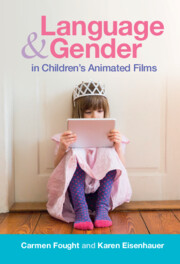Book contents
- Language and Gender in Children’s Animated Films
- Language and Gender in Children’s Animated Films
- Copyright page
- Dedication
- Contents
- Figures
- Tables
- Preface
- Acknowledgments
- 1 Introduction
- 2 Gender, Disney, and Pixar in Historical Context
- 3 Representation, Speech Amounts, and Talkativeness
- 4 Compliments
- 5 Directives
- 6 Insults
- 7 Apologies
- 8 Representing Queerness
- 9 Conclusion
- References and Filmography
- Index
4 - Compliments
Published online by Cambridge University Press: 01 September 2022
- Language and Gender in Children’s Animated Films
- Language and Gender in Children’s Animated Films
- Copyright page
- Dedication
- Contents
- Figures
- Tables
- Preface
- Acknowledgments
- 1 Introduction
- 2 Gender, Disney, and Pixar in Historical Context
- 3 Representation, Speech Amounts, and Talkativeness
- 4 Compliments
- 5 Directives
- 6 Insults
- 7 Apologies
- 8 Representing Queerness
- 9 Conclusion
- References and Filmography
- Index
Summary
This chapter begins the sociolinguistic journey of the book, focusing on quantitative analysis of compliments alongside more detail-oriented qualitative analysis. Compliments, as a speech act, work to attribute ‘goods’ to others and thus naturally carries larger value judgments about what a society views as ‘good.’ Compliments in childrens’ movies likewise act as a lens to reveal what the filmmakers consider worthy of praise in their characters — and importantly, whether that varies by gender. In Disney and Pixar films, compliment giving is not presented as particularly gendered but receiving compliments skews towards female recipients. Qualitatively, female characters on-screen together are portrayed as using compliments as a routine politeness strategy and female villains use the guise of this practice to hide more nefarious purposes. This chapter also finds some tentative initial evidence linking femininity and politeness. While compliments are used by both male and female characters, the female characters use compliments as a routine politeness or rapport-building strategy, whereas male characters complimenting another outside task-based settings is less routine, and at times even framed as a climatically “big deal.” This suggests that although characters of either gender can compliment, compliments as a routine politeness strategy is still associated more closely with femininity.
- Type
- Chapter
- Information
- Language and Gender in Children's Animated FilmsExploring Disney and Pixar, pp. 76 - 104Publisher: Cambridge University PressPrint publication year: 2022

